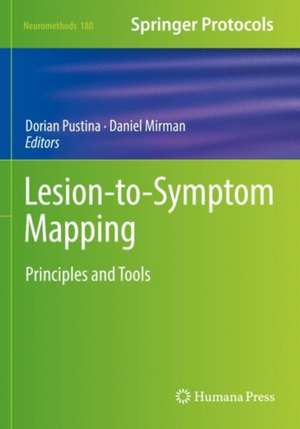Lesion-to-Symptom Mapping: Principles and Tools: Neuromethods, cartea 180
Editat de Dorian Pustina, Daniel Mirmanen Limba Engleză Paperback – 9 iun 2023
Recent developments in lesion-symptom mapping (LSM) have spurred rapid growth. This volume provides comprehensive coverage of the steps and considerations involved in LSM. The chapters cover the definition and types of brain lesions, how to prepare them for analysis, standard LSM methods, network-based LSM methods, and approaches of transient lesions induced by brain stimulation. These chapters are supplemented by practical, hands-on mini tutorials on implementing the different analyses using freely-available software. In the Neuromethods series style, chapters include the kind of detail and key advice from the specialists needed to get started using LSM in your laboratory.
Cutting-edge and thorough, Lesion-to-Symptom Mapping: Principles and Tools connects core conceptual issues with available tools, making it a valuable resource for experienced and new researchers.
| Toate formatele și edițiile | Preț | Express |
|---|---|---|
| Paperback (1) | 952.09 lei 6-8 săpt. | |
| Springer Us – 9 iun 2023 | 952.09 lei 6-8 săpt. | |
| Hardback (1) | 1395.32 lei 6-8 săpt. | |
| Springer Us – 8 iun 2022 | 1395.32 lei 6-8 săpt. |
Din seria Neuromethods
- 5%
 Preț: 347.57 lei
Preț: 347.57 lei - 15%
 Preț: 659.53 lei
Preț: 659.53 lei - 15%
 Preț: 665.08 lei
Preț: 665.08 lei - 18%
 Preț: 986.63 lei
Preț: 986.63 lei - 24%
 Preț: 852.89 lei
Preț: 852.89 lei - 18%
 Preț: 953.03 lei
Preț: 953.03 lei - 18%
 Preț: 955.25 lei
Preț: 955.25 lei - 20%
 Preț: 1129.36 lei
Preț: 1129.36 lei - 20%
 Preț: 1252.04 lei
Preț: 1252.04 lei - 18%
 Preț: 1291.45 lei
Preț: 1291.45 lei - 15%
 Preț: 652.31 lei
Preț: 652.31 lei - 18%
 Preț: 955.70 lei
Preț: 955.70 lei - 23%
 Preț: 705.39 lei
Preț: 705.39 lei - 18%
 Preț: 973.38 lei
Preț: 973.38 lei - 18%
 Preț: 964.86 lei
Preț: 964.86 lei - 18%
 Preț: 968.03 lei
Preț: 968.03 lei - 15%
 Preț: 662.95 lei
Preț: 662.95 lei - 15%
 Preț: 646.43 lei
Preț: 646.43 lei - 15%
 Preț: 649.71 lei
Preț: 649.71 lei -
 Preț: 395.29 lei
Preț: 395.29 lei - 19%
 Preț: 580.67 lei
Preț: 580.67 lei - 19%
 Preț: 584.12 lei
Preț: 584.12 lei - 19%
 Preț: 566.41 lei
Preț: 566.41 lei - 15%
 Preț: 652.17 lei
Preț: 652.17 lei - 15%
 Preț: 655.13 lei
Preț: 655.13 lei - 18%
 Preț: 959.36 lei
Preț: 959.36 lei - 15%
 Preț: 652.49 lei
Preț: 652.49 lei - 15%
 Preț: 649.54 lei
Preț: 649.54 lei - 15%
 Preț: 649.87 lei
Preț: 649.87 lei - 15%
 Preț: 650.19 lei
Preț: 650.19 lei - 15%
 Preț: 648.42 lei
Preț: 648.42 lei - 18%
 Preț: 1039.22 lei
Preț: 1039.22 lei - 18%
 Preț: 963.15 lei
Preț: 963.15 lei
Preț: 952.09 lei
Preț vechi: 1161.08 lei
-18% Nou
Puncte Express: 1428
Preț estimativ în valută:
182.18€ • 190.72$ • 150.74£
182.18€ • 190.72$ • 150.74£
Carte tipărită la comandă
Livrare economică 05-19 aprilie
Preluare comenzi: 021 569.72.76
Specificații
ISBN-13: 9781071622278
ISBN-10: 1071622277
Ilustrații: XVI, 348 p. 113 illus., 106 illus. in color.
Dimensiuni: 178 x 254 mm
Greutate: 0.64 kg
Ediția:1st ed. 2022
Editura: Springer Us
Colecția Springer
Seria Neuromethods
Locul publicării:New York, NY, United States
ISBN-10: 1071622277
Ilustrații: XVI, 348 p. 113 illus., 106 illus. in color.
Dimensiuni: 178 x 254 mm
Greutate: 0.64 kg
Ediția:1st ed. 2022
Editura: Springer Us
Colecția Springer
Seria Neuromethods
Locul publicării:New York, NY, United States
Cuprins
Defining the Lesion for Lesion Symptom Mapping.- Manual Lesion Segmentation.- Automated Lesion Segmentation.- Mapping the Spatial Distribution of Lesions in Stroke: Effect of Diffeomorphic Registration Strategy in the ATLAS Dataset.- Voxel-Based Lesion Symptom Mapping.- Statistical Considerations in Voxel-Based Lesion Behavior Mapping.- Voxel-Based Brain-Behavior Mapping in Neurodegenerative Diseases.- Lesion Network Mapping: From a Topologic to Hodologic Approach.- Connectome-Based Lesion-Symptom Mapping using Structural Brain Imaging.- Lesion Network Mapping using Resting State Functional Connectivity MRI.- Multivariate Lesion-Behavior Mapping.- Lesion-Based Prediction and Predictive Inference.- Selecting and Handling Behavioral Measures for Lesion-Symptom Mapping.- Lesion-Behavior Awake Mapping with Direct Cortical and Subcortical Stimulation.- Transcranial Magnetic Stimulation Mapping for Perceptual and Cognitive Functions.- Apprendix A Introduction.- Lesion-Behavior Mapping Using NPM.- VLSM with VOXBO.- Get Software Running.- Lesion Analysis with NiiStat Tutorial.- Lesion-Symptom Mapping Analyses using LESYMAP.- Network Modification Tool 2.0.- Appendix B Introduction.- Automated Lesion Segmentation using LINDA.- Overview of Automated Lesion Segmentation with lesion_gnb.
Textul de pe ultima copertă
Recent developments in lesion-symptom mapping (LSM) have spurred rapid growth. This volume provides comprehensive coverage of the steps and considerations involved in LSM. The chapters cover the definition and types of brain lesions, how to prepare them for analysis, standard LSM methods, network-based LSM methods, and approaches of transient lesions induced by brain stimulation. These chapters are supplemented by practical, hands-on mini tutorials on implementing the different analyses using freely-available software. In the Neuromethods series style, chapters include the kind of detail and key advice from the specialists needed to get started using LSM in your laboratory.
Cutting-edge and thorough, Lesion-to-Symptom Mapping: Principles and Tools connects core conceptual issues with available tools, making it a valuable resource for experienced and new researchers.
Caracteristici
Includes cutting-edge methods and protocols Provides step-by-step detail essential for reproducible results Contains key notes and implementation advice from the experts
